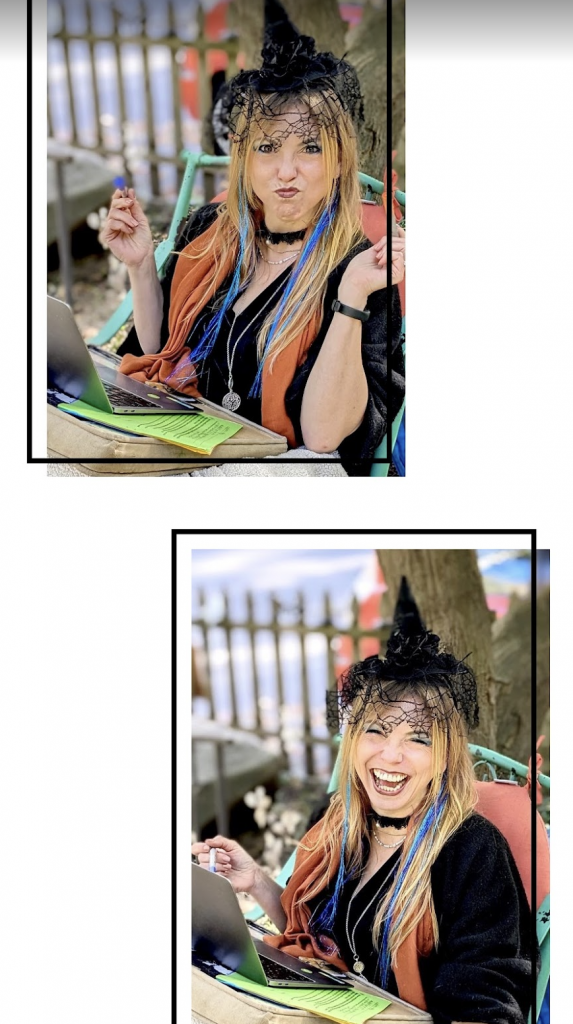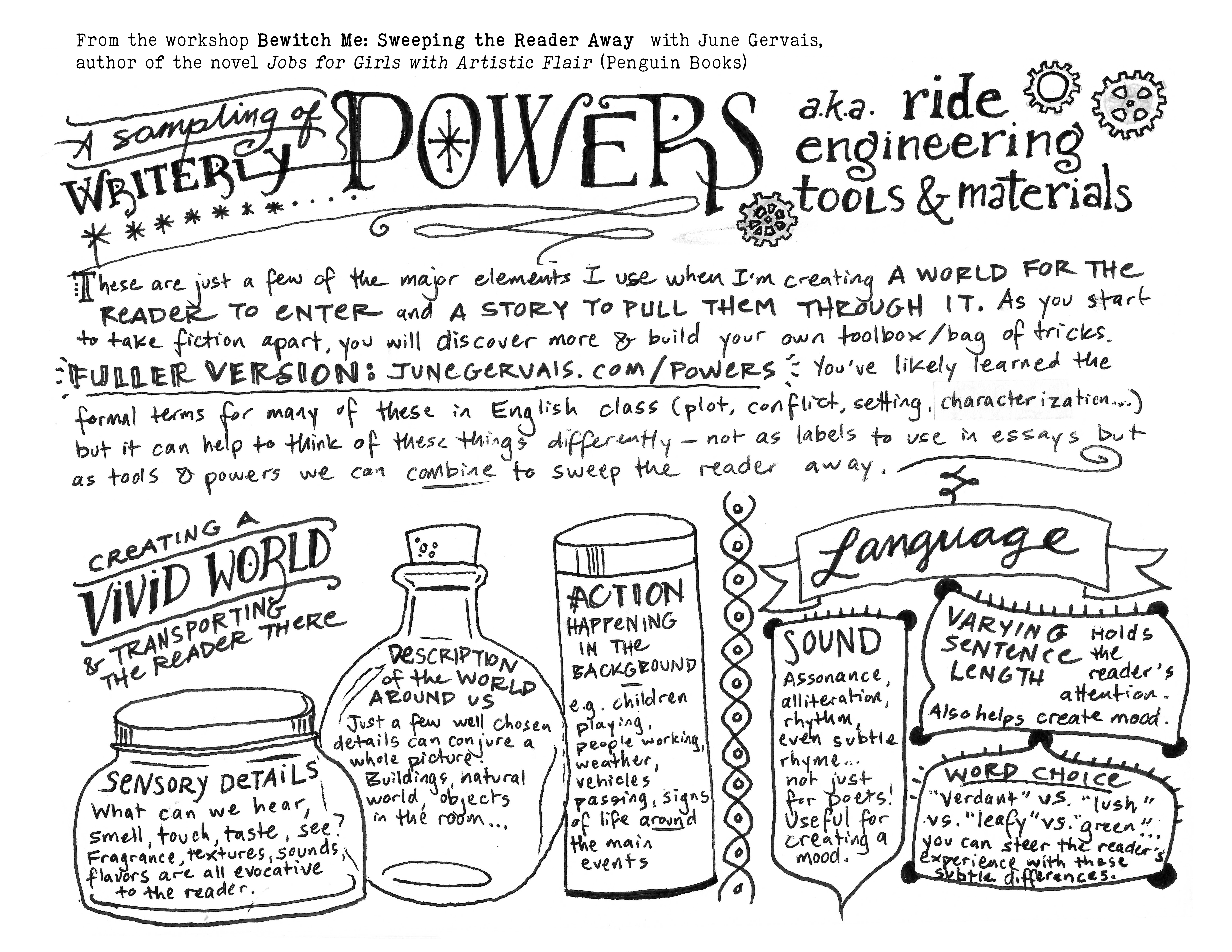If You’re a Young Fiction Writer, I Drew This For You
 I was recently invited to lead a writing workshop for high school students—maybe you’re one of them! If so, hi again!—which I called Bewitch Me: Sweeping the Reader Away.
I was recently invited to lead a writing workshop for high school students—maybe you’re one of them! If so, hi again!—which I called Bewitch Me: Sweeping the Reader Away.
This topic came about when I started pondering
“What is the single most useful thing I can offer these students in a short period of time?”
and what came to me was this:
When we read a spellbinding work of literature that sweeps us away,
it may seem the author has mastered some singular writerly power
in which they effortlessly channel another world onto the page and set us loose in it.
That’s thrilling when we’re reading a book… but may become discouraging when we’re trying to write one. When we sit down to create our own fiction, and it feels flat, or slow, or clunky, or the writing process turns out to be baffling and overwhelming, it’s natural to think: How can I ever possibly achieve what that author achieved?
In fact, though, writing a novel isn’t like casting a single powerful spell.
It’s much more like casting a thousand (or more) little spells
that all work together to keep the reader enthralled.
Dialogue that’s concise, but also feels meaty and zesty and moves the plot along. Stakes that make you care. Well-crafted scenes. Skillful complications. Visual and other sensory descriptions that evoke the world. Word choice, rhythm, insight and meaning-making…
(Another analogy I’ve used in the past is designing and building a haunted house ride. More about that here, in the intro to my series Gears and Ghosts.)
None of us are naturally good at everything, so as young writers, we tend to lean on our strengths. Identifying and learning other writerly powers, though–powers we can acquire, even if we don’t have them yet–makes fiction fuller and more immersive and compelling.
Anyway, I created these handouts for the workshop (see below)… but there was so much more to say! So 1) thanks for spending an hour with me, guys, and 2) here’s a written version of that list, expanded with a few more items that didn’t fit on the handout.
Cheers and happy writing,
June
![]()
![]()
![]()
A few of the powers
(a.k.a. ride engineering tools)
we have available to us as fiction writers
These are just a few of the major elements that I use when I’m trying to create a world for the reader to enter and a story that will pull them through it. If you start to make a habit of taking fiction apart, you will discover more and start to build your own toolbox/bag of tricks.
You’ve likely learned the formal terms for many of these (plot, conflict, setting, characterization) but sometimes it helps to think about these things differently—not as English class labels, but as tools or powers we can draw on and use to sweep the reader away.
Holding our attention: kicking things off and making us care
When you’re trying to begin a story (or the plot is starting to falter at any point in your story), try asking yourself: What are some things that cause fear or desire in real life, in myself or people I know? Even if the specifics differ from your reader’s life, they’re very likely rooted in universal human fears/desires that your reader will identify with.
Often these combine two forces working against each other. Here are just a few examples:
- A desire + an obstacle to achieving it.
- A fear + a reason to believe it might come true.
- A goal + a dire consequence if it’s not achieved.
- A potential romantic relationship that we do or don’t want to happen.
- Something of great importance to the character + the risk that they might lose it.
- A situation where something seems amiss—we don’t have all the facts.
- A secret or a lie that could be discovered.
- A bet or a risk with high stakes.
- A character with conflicting pressures on them—people around them are demanding different things.
How you begin and end your chapters also helps capture and hold the reader’s attention:
- Intriguing first sentence/opening paragraph
- Cliffhangers. These don’t have to be dramatic (e.g. literal cliffs and imminent death)–it’s enough that we (the readers) are following a story with characters we care about, and you (the writer) stop just short of telling us the next thing we’re dying to know.
Moving the story along
- Events told in summary
- Events happening in scene
- Dialogue
- Gestures or physical actions
- Backstory (the past recounted in summary)
- Flashbacks (the past happening in scenes)
- Complications: Sudden external events (or changes in the character) that change the course of the story.
- Emotional shifts: Moments where the character has a change in emotional state, e.g. fear giving way to anger, or surprise to relief.
- Sudden dramatic events or external stimuli. How can you take your character by surprise?
- Decisions: Can you put your character in a position where they have to make a decision? Character taking action: Events will happen to your character—but also, what can they cause to happen? Give them agency to take action. Even (sometimes especially!) if that means allowing them to make mistakes.
Bonus tip: Effective fiction often alternates scene and summary: summary when we need a bird’s-eye view of what’s going on or time passing, scene (dialogue, action in the moment, details of setting, etc.) when the writer wants to bring us in close and experience something firsthand. If your story feels flat, check if it’s heavy on summary and you need to add more scenes.
Creating a vivid world and transporting the reader there
- Sensory descriptions: One of my favorites! What can your character smell, hear, touch, see, taste?
- Descriptions of the world around us: what a room looks like, the natural world, buildings, objects. A few well chosen details can evoke a whole picture.
- Action happening in the environment (e.g. weather, voices from a far-off argument, street performers, someone washing windows…)
Creating people and helping us experience the world through their eyes
- The character’s sensations: What’s going on in their body at a given moment?
- The character’s emotions: What are they feeling at a given moment?
- The character’s thoughts: What are they thinking at a given moment?
- The character’s internal reactions: How are they responding to what’s around them?
- The character’s perception of what they’re seeing: How are they interpreting what’s going on around them?
- Insight and meaning-making. Does it give them new insights on the world, their own life, some aspect of what it’s like to be human?
- Desires and fears
- Speech: What’s their specific way of speaking? Expressions they often use, level of formality?
- Physical characteristics/appearance: Some writers believe it’s important to describe in detail what characters look like; some believe it shouldn’t be necessary. (What do you think? Does it depend on the story you’re trying to tell?)
- The characters’ relationships to each other. How do different combinations of characters feel/behave when they have to interact?
Language
Tools of sound: assonance, alliteration, rhythm, even rhyme. You likely learned about these in a poetry context, but prose writers use them too.
Varying sentence length. Notice how the length of a sentence affects the mood it creates! E.g. several short sentences in a row can be useful for creating a sense of urgency, as in a fight scene. Longer sentences feel more meditative and thoughtful.
Word choice. How does “verdant” feel different from “lush” or “leafy” or just plain “green”? The most elevated vocabulary word isn’t always the best one for the mood you’re trying to evoke.
Helping us see in a fresh way
Metaphors, similes, analogies. Try going through your work and identifying anything that’s a cliché. Can you replace it with a metaphor/simile we haven’t seen before?
Combining details in an interesting way—e.g. choosing details that don’t add up to a familiar stereotype.
